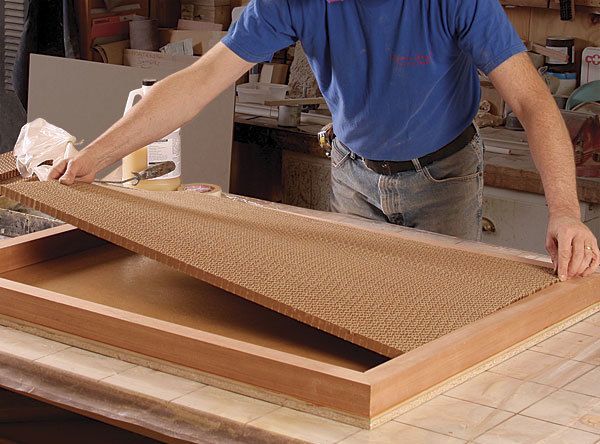How to Make Thick, Light Tabletops
Torison-box design works for any size table.

Synopsis: How do you make a contemporary tabletop that’s 3 to 4 in. thick that can still be lifted without the use of a crane? Simple … use torsion-box construction. Not the old way of making torsion boxes, where you build a solid wood frame and fill it with a latticework of crosspieces. This is a relatively modern take, with the labor-intensive latticework core replaced with resin-impregnated cardboard that resembles a honeycomb. The stuff is easy to cut, easy to use, and very lightweight, but you do need a vacuum bag. The honeycomb helps create a perfect substrate for veneer.
From Fine Woodworking #219
From conference tables to coffee tables, many contemporary designs use thick tops—2 in., 3 in., even 4 in. thick. However, making these from solid wood presents problems. They are tremendously heavy, and they require a lot of expensive wood and labor to flatten them.
The solution is the torsion box. With it, you can make thick tops that are flat, stable, strong, and fairly lightweight. I’m not talking about the old way of making torsion boxes, where you build a solid wood frame and fill it with a latticework of crosspieces. I’m talking about a relatively modern take, with the labor-intensive latticework core replaced with resin-impregnated cardboard that resembles a honeycomb. The stuff is easy to cut, easy to use, and very lightweight, but you do need a vacuum bag.
The honeycomb helps create a perfect substrate for my favorite veneers. You often see it used in large pieces, like conference tables, but you can use it to make a top of any size or any thickness. Once you’ve used this honeycomb core, you’ll never build a latticework torsion box again.
What is this stuff? Resin-impregnated honeycomb sheets are available from Vacuum Pressing Systems (vacupress.com) in 2-ft. by 4-ft. sizes and in 1⁄2-in., 3⁄4-in., and 1-in. thicknesses ($12, $17, and $20, respectively).
The honeycomb is placed within a solid-wood frame and glued between two MDF skins. The honeycomb sheets can be glued using any woodworking glue, but I use Unibond 800 (vacupress.com), a two-part urea-formaldehyde resin. Unibond gives me plenty of open time, and it experiences very little creep and shrinkage, which makes for extremely stable tops. For this application, I use a 4-to-1 ratio of resin to powder, which gives me an open time of about 35 to 45 minutes (with a shop temperature close to 70°F). The entire assembly is glued together in a vacuum bag.
The photos on these pages show you how to build a 2 1⁄2-in.- thick top, but the process is the same no matter what thickness top you are making.
Make a cardboard sandwich, then put it in a bag First, you need to build a solid-wood frame the same thickness as the core materials. Darryl Keil, owner of Vacuum Pressing Systems, says a good rule of thumb is to make the frame about as wide as it is thick. The frame should be made from a stable species, such as poplar or quartersawn mahogany (used here) to minimize wood movement. I miter the frame to avoid having to glue edge veneer over end grain.
For the full article, download the PDF below:
Fine Woodworking Recommended Products

Estwing Dead-Blow Mallet

Festool DF 500 Q-Set Domino Joiner

Jorgensen 6 inch Bar Clamp Set, 4 Pack








Log in or create an account to post a comment.
Sign up Log in